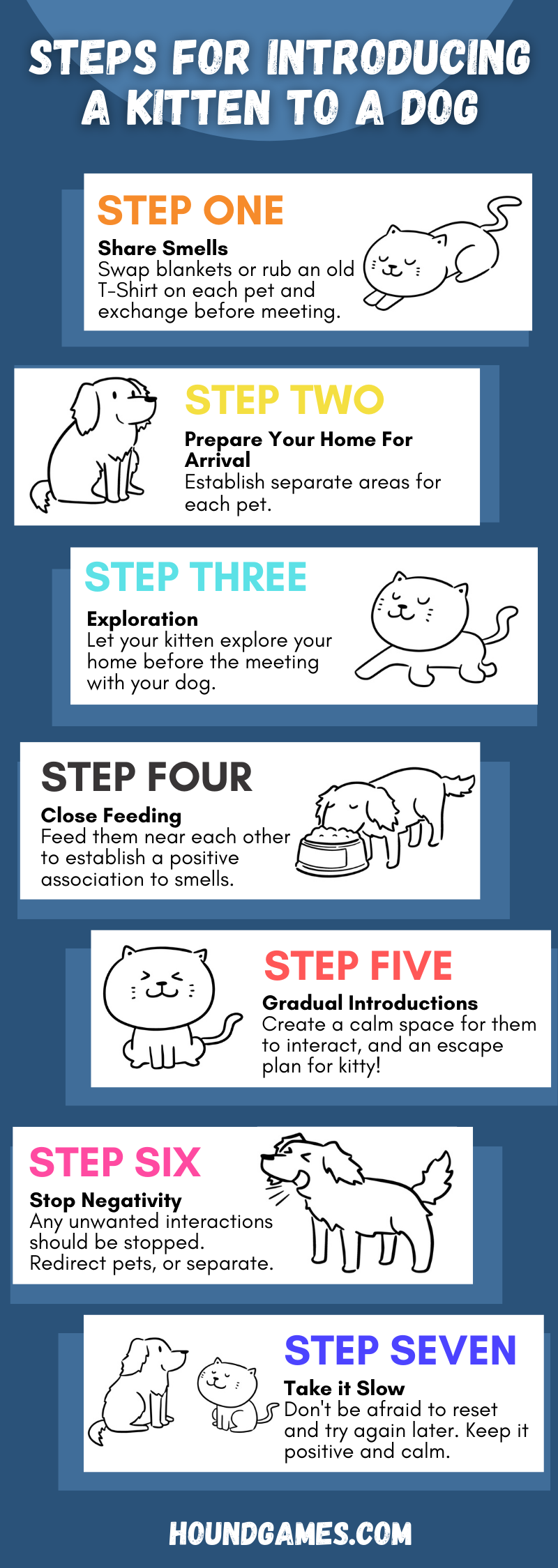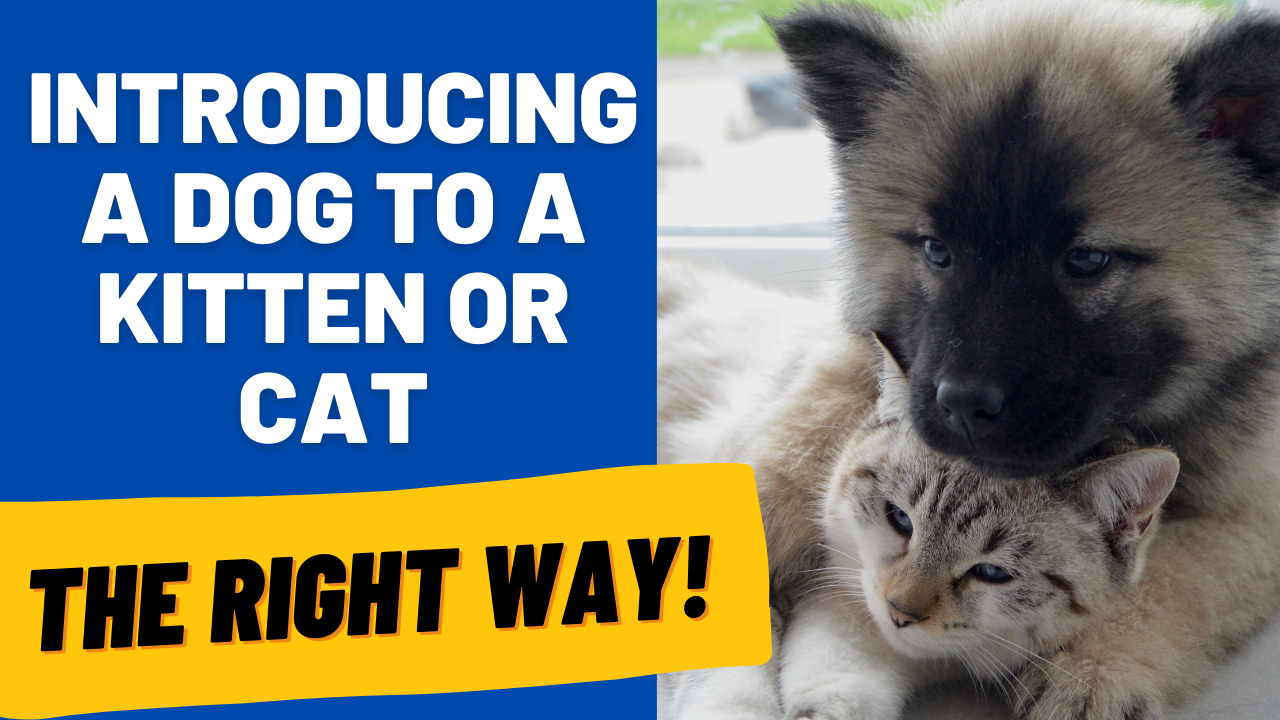Introducing a dog to a kitten or new cat correctly is vital for a peaceful household. When you bring home your kitten or new cat to meet your dog, it’s important to prepare for success. Of the highest importance is ensuring the safety of both kitten and dog.
How do I introduce my kitten to my dog?
The first meeting between your new kitten and your dog may cause both animals to experience a stressful period as they get used to each other’s company.
While some dogs get along better with new cats than others, others may not. Here is a guide on introducing your new kitten to your dog:

Step 1 – Swap their blankets to get them used to each other’s scent. They might not be receptive to the new scent right away. They will, however, grow accustomed to it and become more comfortable with it over time.
Before bringing home your kitten, ask the breeder if they mind rubbing a cloth or old t-shirt on the kitten’s body. Bring that home for your dog to smell. Let them sniff it often so when they meet, your dog is familiar with the scent already. And vice versa.
Step 2 – Prepare your home and pets in advance before bringing home a new cat or kitten. Make sure that the new kitten has their place and places where they can get away from your dog if they need to. They will also need their separate areas for food, litter, and bed.
Step 3 – Allow your kitten some time to adjust to their new surroundings before introducing them to everyone. This will help to relieve the kitten’s stress. If the kitten appears stressed and fearful, it may be best to keep your dog away from the kitten until the kitten has adjusted to the new environment.
Step 4 – Feed your kitten and dog on opposite sides of a door, or beside each other if they seem comfortable. This will introduce the scents of your pets to one another. It will also help in associating each other’s scent with something positive.
Step 5 – Begin gradually introducing each pet to each other’s areas and items. For example, allow your dog to visit your cat’s area for a few minutes at a time, and vice versa. These moments must occur during calm periods.
Step 6 – As soon as your kitten feels comfortable in their new home and your dog has adjusted to the new family member, it’s time to introduce them. Make sure they meet in a calm, comfortable area where your kitten can escape if necessary.
Before meeting the new kitten, ensure your dog is fed and exercised to release any pent-up energy.
Step 7 – Allow them to spend a few minutes together. Extend the time gradually if they appear comfortable with each other’s company. If you notice any negative response, put a stop to it right away and calmly distract and separate the pets.
Again, it is critical to provide proper behavioral training to prevent aggressive actions and be consistent to ensure socialization success.
Step 8 – Be aware of any stress signals and any hunting cues from your dog, such as preparing to lunge. It is best to remain present whenever they spend time together until you are confident that they are comfortable with one another.
Additionally, if your kitten is hissing at your dog, they could be stressed as well.
If you notice aggression from your dog toward your kitten or new cat, be sure to read our post, Will My Dog Kill My Cat? (Breeds and Chances)
Step 9 – If a kitten or cat meets two dogs at the same time, they may become overwhelmed, so introduce them one at a time. Once the cat is confident with each dog separately, you can begin introducing the dogs together.
If you are introducing your dog to a rabbit, be sure to read our post, Will My Dog Kill My Rabbit? Answered!
How long does it take for a dog to get used to a kitten?
While some dogs can take a few minutes to get used to a kitten, others could take several weeks or even months. Each dog will have a different time frame for getting used to a kitten. This will depend on factors such as breed, temperaments, and personalities. For example, a shy kitten that runs away from an excited dog with an instinct to chase, may take much longer to learn to interact with one another.
It is crucial to be calm, patient and take your time when introducing your new cat to your dog, since a negative experience for either the cat or the dog can cause long-term problems.
What if my dog is chasing my kitten or new cat around?
A dog chasing a cat could be playing, giving chase to “prey”, or showing signs of aggression. Either way, it’s important to intervene swiftly. Separate your dog from the cat and don’t allow them together unsupervised. Exercise your dog and get rid of any excess energy.
Thereafter, bring them into a room with your cat while they are on a leash for short sessions. Keep treats and a favorite toy with you to keep their attention on you. If their eyes wander to the cat, and they begin to stare or fixate, correct them with a sharp “no”.
Bring their attention back to you with training exercises that promote controlled behaviors such as “stay” or place training. Do not let your dog become excited and be sure to reward calm behavior.
Ultimately, the aim is to teach your dog that calmness is the correct state when the cat is present.
Is your dog being aggressive toward the cat?
It’s critical to be aware of the warning signs and subtle cues that your dog displays that may be warning signs of aggression toward your cat or kitten.
By being aware of these signals, you can help your dog learn appropriate behavior and keep your cat safe.
Here’s a list of signs that your dog is being aggressive toward your cat:
- Visual tracking – your dog will have an intense stare and start tracking your cat’s movements. If you see that your dog is staying very still and intensely watching your cat, it could be a sign of aggression towards your cat.
- Deep or low growling – your dog’s low and deep growl is a warning to others to back off. It is caused by aggressive behavior, such as your dog being territorial.
- Assuming attack stance – after visual tracking, your dog will assume the attack stance to show aggression. Their muscles are usually tense during this time, ears are usually pricked and the tail is often upright and stiff.
- Raised hackles – if you see that your dog raises his hackles around your cat, he’s on high alert. Often, you will also see them be still and rigid, which are all signs of aggression.
- Slowly wagging tail – sometimes the tail may not be completely still but could wag stiffly and slowly
- Barking – while barking can mean many things, specifically barking at your cat indicates aggression or overexcitement. They’ll be tense and fixated on your cat.
- Chasing or lunging – as stated above, chasing and lunging needs direct intervention.
- Baring teeth or snarling – if you see your dog clenching his teeth or snarling at your cat, they are agitated by the cat’s presence. This behavior is one of the more obvious signs of aggression in your dog.
- Biting – while your dog can playfully bite and nip, biting your cat will be more intense and sudden if it’s due to aggression. You will frequently see the other aggressive behavior signs along with the biting.
Many dogs will start slowly with an intense and fixated stare, giving you time to intervene. But highly reactive dogs can move directly to chasing and biting. This is a dangerous situation and the animals will need to be separated immediately..
Should you let the dog and cat fight it out?
It’s never a good idea to let the dog and the cat fight it out. For corrective behavior and training to be successful, any negative behaviors must be stopped as soon as they occur. You also risk the chance of one or both of them getting hurt. Negative associations are also hard to undo in a dog and even harder in a cat.
Rather than risking injury and a mortal feud, you should do everything possible to prevent a fight from ever occurring.
For the time being, they may need to be separated from one another for an extended period until they have both learned how to behave appropriately around one another.
Can you trust your dog with your cat or kitten?
Even if you already have another cat at home, you should not immediately trust your dog with the new cat until you thoroughly assess how they interact. You must remember that each cat has a unique personality and a cat with whom your dog is familiar and compatible may not have the same relationship with your dog. This is regardless of whether your dog has been properly socialized.
Furthermore, a friendly and large dog may be too rough with a kitten and injure it. It’s best to take all the precautions and be safe for everyone’s sake. Besides, if your dog and the new cat get along, you won’t have to wait long before you can trust your dog with your cat or kitten.
When a dog is too excited with a new cat
A dog that is too excited with a new cat can cause the cat to become scared and hostile. This can make the first introduction a negative one, especially if the cat lashes out. To prevent excitement, follow the steps for introducing a cat to a dog and for when a dog chases a cat. The aim is to teach the dog to be calm in the presence of a cat.
Conclusion
Dogs and cats can get along well in most households. How well they are introduced will impact long-term success. A scared and overwhelmed cat may hiss or swipe at a dog, while a dog can be overexcited by the new arrival or act aggressively toward the “intruder.” If the first encounter is a negative one for either pet, this can become a long-term problem.
Always take the necessary steps to introduce a new cat or kitten to your dog carefully and in a controlled and calm environment.




